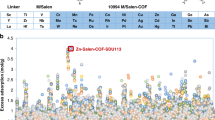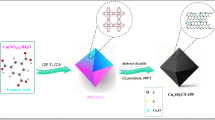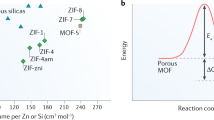Abstract
Understanding the mechanism by which porous solids trap harmful gases such as CO2 and SO2 is essential for the design of new materials for their selective removal. Materials functionalized with amine groups dominate this field, largely because of their potential to form carbamates through H2N(δ−)···C(δ+)O2 interactions, thereby trapping CO2 covalently. However, the use of these materials is energy-intensive, with significant environmental impact. Here, we report a non-amine-containing porous solid (NOTT-300) in which hydroxyl groups within pores bind CO2 and SO2 selectively. In situ powder X-ray diffraction and inelastic neutron scattering studies, combined with modelling, reveal that hydroxyl groups bind CO2 and SO2 through the formation of O=C(S)=O(δ−)···H(δ+)–O hydrogen bonds, which are reinforced by weak supramolecular interactions with C–H atoms on the aromatic rings of the framework. This offers the potential for the application of new ‘easy-on/easy-off’ capture systems for CO2 and SO2 that carry fewer economic and environmental penalties.
This is a preview of subscription content, access via your institution
Access options
Subscribe to this journal
Receive 12 print issues and online access
$259.00 per year
only $21.58 per issue
Buy this article
- Purchase on Springer Link
- Instant access to full article PDF
Prices may be subject to local taxes which are calculated during checkout






Similar content being viewed by others
References
Keith, D. W. Why capture CO2 from the atmosphere? Science 325, 1654–1655 (2009).
Villiers, C., Dognon, J. P., Pollet, R., Thuery, P. & Ephritikhine, M. An isolated CO2 adduct of a nitrogen base: crystal and electronic structures. Angew. Chem. Int. Ed. 49, 3465–3468 (2010).
Rochelle, G. T. Amine scrubbing for CO2 capture. Science 325, 1652–1654 (2009).
Long, J. R. & Yaghi, O. M. The pervasive chemistry of metal-organic frameworks. Chem. Soc. Rev. 38, 1201–1507 (2009).
D'Alessandro, D. M., Smit, B. & Long, J. R. Carbon dioxide capture: prospects for new materials. Angew. Chem. Int. Ed. 49, 6058–6082 (2010).
Wang, B., Coté, A. P., Furukawa, H., O'Keeffe, M. & Yaghi, O. M. Colossal cages in zeolitic imidazolate frameworks as selective carbon dioxide reservoirs. Nature 453, 207–212 (2008).
Li, Q. W. et al. Docking in metal-organic frameworks. Science 325, 855–859 (2009).
Lin, X., Champness, N. R. & Schröder, M. Hydrogen, methane and carbon dioxide adsorption in metal-organic framework materials. Top. Curr. Chem. 293, 35–76 (2010).
Sumida, K. et al. Carbon dioxide capture in metal-organic frameworks. Chem. Rev. 112, 724–781 (2012).
Matsuda, R. et al. Highly controlled acetylene accommodation in a metal-organic microporous material. Nature 436, 238–241 (2005).
Tozawa, T. et al. Porous organic cages. Nature Mater. 8, 973–978 (2009).
Dawson, R., Adams, D. J. & Cooper, A. I. Chemical tuning of CO2 sorption in robust nanoporous organic polymers. Chem. Sci. 2, 1173–1177 (2011).
Vaidhyanathan, R. et al. Direct observation and quantification of CO2 binding within an amine-functionalized nanoporous solid. Science 330, 650–653 (2010).
Zhang, J-P. & Chen, X-M. Optimised acetylene/carbon dioxide sorption in a dynamic porous crystal. J. Am. Chem. Soc. 131, 5516–5521 (2009).
Takamizawa, S. et al. Crystal transformation and host molecular motions in CO2 adsorption process of a metal benzoate pyrazine (MII = Rh, Cu). J. Am. Chem. Soc. 132, 3783–3792 (2010).
Yang, S. et al. Pore with gate: modulating hydrogen storage in metal-organic framework materials via cation exchange. Faraday Discuss. 151, 19–36 (2011).
Ibarra, I. et al. Near critical water, a cleaner solvent for the synthesis of a metal-organic framework. Green Chem. 14, 117–122 (2012).
Lin, X. et al. High capacity hydrogen adsorption in Cu(II) tetracarboxylate framework materials: the role of pore size, ligand functionalization, and exposed metal sites. J. Am. Chem. Soc. 131, 2159–2171 (2009).
Yan, Y. et al. A mesoporous metal-organic framework constructed from a nanosized C3-symmetric linker and [Cu24(isophthalate)24] cuboctahedra. Chem. Commun. 47, 9995–9997 (2009).
Férey, G. & Serre, C. Large breathing effects in three-dimensional porous hybrid matter: facts, analyses, rules and consequences. Chem. Soc. Rev. 38, 1380–1399 (2009).
Spek, A. L. Structure validation in chemical crystallography. Acta Crystallogr. D 65, 148–155 (2009).
Demessence, A., D'Alessandro, D. M., Foo, M. L. & Long, J. R. Strong CO2 binding in a water-stable, triazolate-bridged metal-organic framework functionalized with ethylenediamine. J. Am. Chem. Soc. 131, 8784–8785 (2009).
McDonald, T. M. et al. Capture of carbon dioxide from air and flue gas in the alkylamine-appended metal–organic framework mmen-Mg2(dobpdc). J. Am. Chem. Soc. 134, 7056–7065 (2012).
Ramirez-Cuesta, A. J. aCLIMAX 4.0.1, The new version of the software for analyzing and interpreting INS spectra. Comput. Phys. Commun. 157, 226–238 (2004).
Mitchell, P. C. H., Parker, S. F., Ramirez-Cuesta, A. J. & Tomkinson, J. Vibrational Spectroscopy with Neutrons with Applications in Chemistry, Biology, Material Sciences and Catalysis (World Scientific, 2005).
Chen, B. et al. Surface interactions and quantum kinetic molecular sieving for H2 and D2 adsorption on a mixed metal-organic framework material. J. Am. Chem. Soc. 130, 6411–6423 (2008).
Caskey, S. R., Wong-Foy, A. G. & Matzger, A. J. Dramatic tuning of carbon dioxide uptake via metal substitution in a coordination polymer with cylindrical pores. J. Am. Chem. Soc. 130, 10870–10871 (2008).
Thompson, S. P. et al. Beamline I11 at Diamond: a new instrument for high resolution powder diffraction. Rev. Sci. Instrum. 80, 075107 (2009).
Rietveld, H. M. A profile refinement method for nuclear and magnetic structures. J. Appl. Crystallogr. 2, 65–71 (1969).
Palatinus, L. & Chapuis, G. Superflip—a computer program for the solution of crystal structures by charge flipping in arbitrary dimensions. J. Appl. Crystallogr. 40, 786–790 (2007).
Acknowledgements
S.Y. acknowledges receipt of a Leverhulme Trust Early Career Research Fellowship, and M.S. the receipt of an ERC Advanced Grant and EPSRC Programme Grant. The authors acknowledge funding from the EPSRC and the University of Nottingham, and are especially grateful to Diamond Light Source and ISIS Neutron Centre for access to Beamlines I11 and TOSCA, respectively. The authors thank the user support group at ISIS (C. Goodway and M. Kibble) for technical help at ISIS beamline TOSCA, M. Fray for help with TEM measurements, and K. Refson for discussions on DFT modelling. J.S. acknowledges support from the Swedish Research Council (VR).
Author information
Authors and Affiliations
Contributions
S.Y., D.P.A. and R.N. carried out syntheses of the MOF samples. J.S. and W.I.F.D. contributed to solution and refinement of the structures from PXRD data. S.Y. characterized the MOF samples and carried out measurements and analysis of adsorption isotherms. S.Y., A.J.B., C.C.T. and J.E.P. collected and analysed the synchrotron X-ray powder diffraction data. S.Y., S.K.C. and A.J.R.C. collected and analysed the neutron scattering data and carried out DFT modelling of the neutron scattering data. M.S. and S.Y. were responsible for the overall direction and design of the project and preparation of the manuscript, with contributions from all authors.
Corresponding authors
Ethics declarations
Competing interests
The authors declare no competing financial interests.
Supplementary information
Supplementary information
Supplementary information (PDF 5020 kb)
Supplementary information
Fractional coordinates for compound NOTT-300-solvated (CIF 1 kb)
Supplementary information
Fractional coordinates for compound NOTT-300-3.2CO2 (CIF 1 kb)
Supplementary information
Fractional coordinates for compound NOTT-300-4SO2 (CIF 2 kb)
Rights and permissions
About this article
Cite this article
Yang, S., Sun, J., Ramirez-Cuesta, A. et al. Selectivity and direct visualization of carbon dioxide and sulfur dioxide in a decorated porous host. Nature Chem 4, 887–894 (2012). https://doi.org/10.1038/nchem.1457
Received:
Accepted:
Published:
Issue Date:
DOI: https://doi.org/10.1038/nchem.1457
This article is cited by
-
Preparation of UiO-66-type adsorbents for the separation of SO2 from flue gas
Adsorption (2024)
-
Direct prediction of gas adsorption via spatial atom interaction learning
Nature Communications (2023)
-
A robust ultra-microporous cationic aluminum-based metal-organic framework with a flexible tetra-carboxylate linker
Communications Chemistry (2023)
-
Development of PVA/GO Nanocomposites Membranes for Air-Filtration and Purification
Journal of Inorganic and Organometallic Polymers and Materials (2023)
-
Application of Ca-based adsorbents in fixed-bed dry flue gas desulfurization (FGD): a critical review
Environmental Science and Pollution Research (2023)



